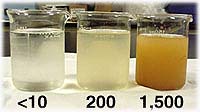Water Quality Parameters: Turbidity
Turbidity is a physical parameter that determines the cloudiness or clarity of water. It is measured in NTUs or nephalometric turbidity units.
Water with noticeable or measurable turbidity is generally unfit for drinking (the drinking water quality standard for turbidity is 1 NTU) and excessive levels can block light from reaching aquatic plants, increase water temperatures and create muddy-bottomed streams uninhabitable for many types of aquatic life.
Some common sources of turbidity include erosion from streambanks, contaminated runoff high in sediment from roads or areas with little or no vegetation, or plant particulates from streams choked with algal or other aquatic plant blooms.
